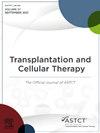Cytokine Release Syndrome and Neurotoxicity Following CD19 CAR-T in B-Cell Lymphoma
IF 3.6
3区 医学
Q2 HEMATOLOGY
引用次数: 0
Abstract
Chimeric antigen receptor T cell (CAR-T) therapy is an effective treatment for relapsed-refractory large B-cell lymphoma (LBCL). However, toxicities, particularly cytokine release syndrome (CRS) and immune effector cell-associated neurotoxicity syndrome (ICANS), remain significant concerns. Analyze temporal trends, risk factors, and associations between these toxicities and their severity. In this registry study by the Center for International Blood and Marrow Transplant Research, we studied CRS and ICANS in 1916 LBCL patients treated with commercial CAR-T therapies (axicabtagene ciloleucel 74.9%, tisagenlecleucel 25.1%) between 2018 and 2020. Outcomes include development of CRS/ICANS, timing and severity according to ASTC grading, overall survival (OS). Risk factors were assessed using Cox proportional hazards model. Among patients developing CRS (75.2%), 11.3% had grade ≥3 CRS. Among patients developing ICANS (43.5%), 47.7% had grade ≥3 ICANS. Among patients developing CRS, severe CRS rates decreased from 14.0% in 2018 to 9.2% in 2020 (P < .01). However, the proportion of severe ICANS in patients who developed ICANS remained statistically unchanged (41.5% in 2018 to 53.7% in 2020, P = .10). CRS and ICANS were correlated: 57.1% of patients with CRS also experienced ICANS, and CRS was reported in 97.5% of ICANS cases, suggesting a potential continuum between toxicities. Axicabtagene ciloleucel was associated with higher risk of any grade CRS (OR, 4.6; 95% CI, 3.65 to 5.81) and ICANS (OR, 5.85; 95% CI, 4.48 to 7.64) as well as early and severe forms of both complications. Older age, lower performance status, and elevated lactate dehydrogenase levels prior to infusion also variably predicted these toxicities. In a landmark analysis starting 30 days postinfusion, patients with severe CRS or severe ICANS had shorter OS compared to those without these toxicities. High grades of CRS improved over time likely related to earlier intervention, development of ICANS is intrinsically related with CRS. These findings underscore the need for effective strategies to mitigate these toxicities and improve CAR-T safety.
细胞因子释放综合征和CD19 CAR-T后b细胞淋巴瘤的神经毒性。
CAR-T细胞疗法是治疗复发难治性大b细胞淋巴瘤(LBCL)的有效方法。然而,毒性,特别是细胞因子释放综合征(CRS)和免疫效应细胞相关神经毒性综合征(ICANS),仍然值得关注。分析时间趋势、危险因素以及这些毒性及其严重程度之间的关联。在国际血液和骨髓移植研究中心的这项注册研究中,我们在2018年至2020年期间研究了1916名接受商业CAR-T疗法(axicabtagene ciloleucel 74.9%, tisagenlecleucel 25.1%)治疗的LBCL患者的CRS和ICANS。结果包括CRS/ICANS的发展,根据ASTC分级的时间和严重程度,总生存期(OS)。采用Cox比例风险模型评估危险因素。在发生CRS的患者中(75.2%),11.3%的CRS≥3级。在发生ICANS的患者中(43.5%),47.7%的患者ICANS≥3级。在发生CRS的患者中,严重CRS的发生率从2018年的14.0%下降到2020年的9.2% (P
本文章由计算机程序翻译,如有差异,请以英文原文为准。
求助全文
约1分钟内获得全文
求助全文
来源期刊

Transplantation and Cellular Therapy
Medicine-Hematology
CiteScore
7.00
自引率
15.60%
发文量
1061
审稿时长
51 days
 求助内容:
求助内容: 应助结果提醒方式:
应助结果提醒方式:


